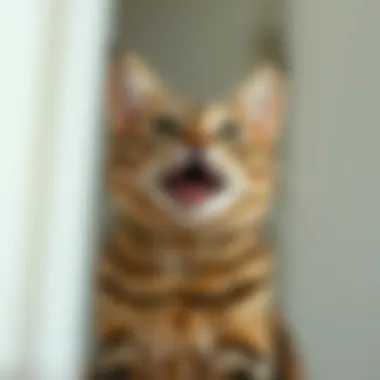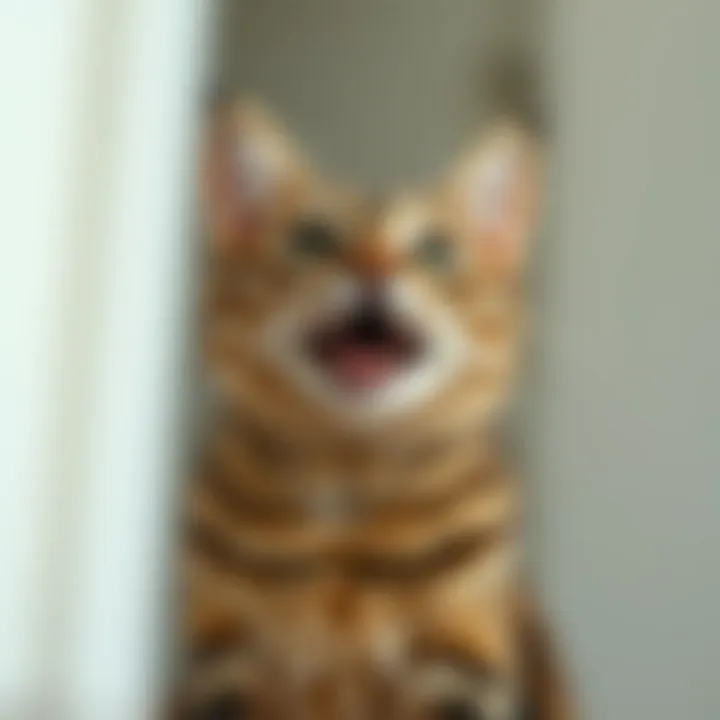Understanding Feline Behavior: Reasons Behind Cat Bites


Animal Species Profile
Preamble to the animal species
Cats, or Felis catus, have long been cherished as companions by humans. They bring warmth and a hint of mystery into our homes, navigating through daily life with a level of grace that often leaves us in awe. Their behaviors, quirks, and interactions with our human world can baffle as much as they delight. Understanding why they sometimes nip or scratch is crucial in fostering a harmonious relationship with these furry creatures.
Physical characteristics and appearance
Typically, domestic cats present a plethora of appearances thanks to interbreeding over generations. From sleek Siamese designs to fluffy Persian coats, there’s a cat for every aesthetic preference. Generally, they weigh between 5 to 20 pounds, though size can be a bit of a mixed bag, depending greatly on breed and environment. What remains consistent across the board are their sharp retractable claws, keen eyesight, and sensitive whiskers, all finely tuned for hunting and navigating their surroundings.
Natural habitat and distribution
Originally, wildcats thrived in various habitats ranging from deserts to forests. Today, their range is almost global, with the highest densities found in urban and suburban areas. Cats have carved their niche not only as hunters but also as adept adapters, making the most of our homes, exploring from sunny windowsills to dark under-couches. This capability has likely contributed to their intense popularity and the establishment of a unique bond with humans.
Behavior and social interactions
Understanding cat behavior involves untangling a web of instincts and learned behaviors. Unlike dogs, who often exhibit pack mentality, cats tend to be more solitary, yet they can form strong social structures in multi-cat households. They communicate through vocalizations, body posture, and scent marking, often projecting a persona that can switch from independent to affectionate in mere moments.
Whether it's a playful pounce or that sudden nip that takes you by surprise, each action holds a deeper significance that reflects their needs and emotional states.
"Cats can seem aloof at times, but every flick of their tail and chirp they make says a thousand words."
Animal Behavior & Psychology
Communication and language cues
Cats use a complex array of sounds and body language to convey their feelings. A soft purr usually signals contentment, while an arched back and puffed fur might indicate fear or aggression. Being attuned to these signals allows humans to respond more effectively to their feline housemates.
Reproductive behavior and parenting
During mating seasons, male cats assertively display their intentions through specific vocalizations and territorial markings. While female cats may appear graceful, they can also demand attention fiercely when in heat. If kittens are present, a mother cat’s instincts kick into high gear as she transforms into a protective guardian, showing an impressive level of care and nurturing towards her young.
Cognitive abilities and problem-solving skills
Cats are incredibly intelligent and exhibit problem-solving abilities that often surprise their owners. They’ve been known to open doors, figure out protocols to access hidden food, and navigate through obstacles with ease. These skills reflect a keen understanding of their environment, bolstered by instinct and experience.
Emotional intelligence and social dynamics
Felines have an emotional intelligence that manifests in how they interact with humans. They often sense when their owners are feeling blue, following them around or seeking closeness. It's these intricate social dynamics that can sometimes lead to aggressive interactions, especially when a cat feels threatened or overstimulated.
Pet Care & Tips
Choosing the right pet for your lifestyle
Adopting a cat isn’t simply a matter of picking a pretty feline. Each cat has a distinct personality. Some cats are more sociable and affectionate, while others lean toward independence. Considering factors like your living arrangement and daily routine is vital in finding a cat that fits seamlessly into your life.
Basic care requirements and habitat setup
Creating a safe and engaging environment for a cat is essential to its well-being. Provide a clean litter box, scratching posts, and interactive toys to stimulate mental faculties. Regular vet visits also ensure your furry friend stays healthy and happy.
Health and wellness tips for pet longevity
Cats thrive on a balanced diet, appropriate exercise, and mental stimulation for longevity. Providing access to fresh water, high-quality cat food, and engaging playtime fosters not only physical health but emotional well-being as well. Regular vet check-ups ensure you catch any health problems before they become serious.
Training techniques and behavioral enrichment ideas
Training a cat requires patience. Use positive reinforcement – treats and affection – to encourage good behavior. Engage your cat with puzzle feeders or toys that mimic hunting; this helps to satisfy their natural instincts and keeps them active.
In summary, understanding feline behavior, especially the reasons behind those scratchy love bites, forms the foundation for better care and a closer bond with your pet. By observing patterns and responding appropriately, you can turn those moments of aggression into opportunities for connection.
Preface to Feline Behavior
Understanding feline behavior is not just a matter of curiosity for cat owners; it plays a crucial role in fostering a harmonious relationship between humans and their feline companions. As most cat lovers appreciate, cats are not merely pets; they are complex beings with their own unique personalities, instincts, and communication styles. Grasping the intricacies of their behavior can therefore enhance not only the wellbeing of the cat but also the satisfaction of owning one.
When it comes to biting, many owners might feel bewildered or even hurt by their cat's actions. This behavior might seem random or aggressive at first glance, but often roots itself in deeper behavioral psychology. For instance, it could stem from play aggression, which reflects a cat’s natural hunting instincts. This connection between instinct and behavior is critical; understanding it can help owners discern when their furry companions are simply playing and when they might be signaling distress or fear.
Key benefits to comprehending feline behavior include:


- Strengthening the bond: The more you know about why your cat behaves a certain way, the better you can respond in a manner that respects their instincts.
- Prevention of negative interactions: By understanding the signs of overstimulation or fear, pet owners can modify their interactions, reducing unwanted bites.
- Promoting wellbeing: A deeper understanding of your cat's psychology allows for tailored environments that align with their needs, enhancing their overall happiness.
Diving deeper into the specifics of feline behavior reveals a variety of motivations for actions like biting. A keen focus on these aspects benefits both the owner and the cat, leading to a more peaceful cohabitation.
The Importance of Understanding Cat Behavior
Cats have evolved over thousands of years to adapt to various environments, and this evolution has shaped their behaviors significantly. Understanding these behaviors isn't just an academic exercise; it fosters compassion and respect towards our feline friends. When an owner recognizes that a cat's biting behavior might be rooted in instinctual drives—like hunting or self-defense—it encourages a shift in perspective.
For instance, take a typical scenario: a cat is playing with its owner using a string toy. As the game progresses, the cat might begin to bite playfully, not because it wants to hurt, but rather as part of its hunting play. If owners misinterpret this as aggression, it could lead to avoidance or punitive reactions, which, in turn, could damage the trust between pet and owner. Hence, understanding this nuance is paramount.
Recognizing why cats exhibit certain behaviors opens the door to a more fulfilling relationship. It leads to less stress for both parties and enhances the joy of companionship that comes with having a cat in the home.
Setting the Context: Why Cats Bite
Biting in cats can happen for a multitude of reasons—many of which stem from basic instincts or emotional responses. It's important to dissect the context in which these bites occur to better interpret their meaning.
One of the most commonly understood reasons cats bite is during play, which can sometimes escalate unexpectedly. Cats, like many animals, have a strong predatory drive. When engaged in what they see as a hunting game, their instinct to pounce or bite can surface, leading to surprising interactions with their owners. However, this biting is generally playful and not meant to inflict pain.
Another context for biting happens when a cat feels overwhelmed. A sudden noise or a swift movement can frighten a cat, causing it to lash out defensively. This behavior is less about aggression and more about self-preservation.
Lastly, some cats may utilize biting as a means of communication. This behavior lays bare a cat’s unique vocabulary which can include gently nipping at your hand to get your attention, letting you know they want to play or require space.
Being aware of the various contexts in which a cat might bite is essential for any owner. This understanding leads to better interactions and demonstrates the importance of emotional intelligence in managing cat behavior.
Common Reasons Cats Bite Their Owners
Understanding why cats bite their owners goes beyond being a mere curiosity. It opens a window into the complex emotional and instinctual landscape of our feline friends. Recognizing the common reasons behind these bites empowers cat owners, helping them to enhance their bond with their pets. This section aims to demystify the various motivations behind a cat's bite, covering play aggression, overstimulation, fear, communication, and redirected aggression.
By learning to interpret these behaviors, cat owners can create safer, more positive experiences for both themselves and their cats. In the following subsections, we will unravel the perplexing world of feline behavior, offering insights that will help improve interactions.
Play Aggression
Understanding Playfulness in Cats
Cats are naturally playful creatures, and their play often resembles hunting. When observing a cat stalking a toy, one can notice the swift movements and focused gaze—the hallmark of a hunter in action. Play aggression becomes confusing when it turns from harmless fun into unexpectedly malevolent bites.
The key characteristic of playfulness is that it mimics real hunting tactics, which are deeply ingrained in their instincts. This behavior is beneficial as it helps cats hone their predatory skills, keeping them sharp and engaged. However, it can lead to injuries if the lines between play and aggression blur.
A unique feature of this playfulness is that it often escalates without warning. Cats may bite during play, unintentionally or otherwise; thus, sharp claws and teeth can cause pain, leading owners to see these innocent acts as aggressive behaviors. Recognizing the playful context is crucial in reducing these moments of surprise.
The Role of Hunting Instincts
The hunting instinct plays a pivotal role in a cat's play aggression. Cats are wired to chase, catch, and pounce; engaging in play serves as an outlet for these instincts. When they target human hands or feet, it's not personal—it's just instinct.
The key characteristic of these instincts is their powerful connection to survival. The natural behaviors ensure that your cat remains physically and mentally stimulated. This is why allowing this type of play is essential for their health. However, if left unchecked, cats may start biting out of excitement or frustration when they don't catch their "prey."
What’s interesting is the dual nature of this behavior. While it offers exercise, it can also lead to dangerous encounters if not managed properly. Ensuring that your cat has appropriate toys can help channel their predatory instincts in safer ways.
Overstimulation
Reading Feline Body Language
Just like humans, cats can become overwhelmed. Recognizing feline body language is vital in preventing biting incidents due to overstimulation. The twitch of a tail, dilated pupils, or flattened ears often signal a cat that’s had enough stimulation.
The key characteristic of feline body language is that it varies subtly but significantly communicates feelings. By understanding these signs, you can better empathize with your cat's emotional state. This understanding is beneficial, as it helps to mitigate conflicts and creates a calmer atmosphere.
Notably, the unique aspect of this communication is the variability in each cat's responses. Some may react more intensely to petting while others might appreciate longer interactions. Learning to read these signals helps build a more harmonious environment.
Identifying the Signs of Overstimulation
Identifying the signs of overstimulation can be tricky. When a cat starts to squirm or swat, it often sounds the alarm for their human. Key characteristics to look for are sudden agitated behaviors and fleeing from the interaction.
Developing the ability to recognize these cues can be a game changer, enhancing your relationship with your cat significantly. An important advantage is that knowing when to stop can prevent bites and scratches that result from an overstimulated cat.
The unique feature of this understanding is that each cat has its own threshold; some may tire quickly, while others like longer play sessions. Watching carefully allows for tailoring interactions to individual preferences, fostering a more positive bond.
Fear and Defense


Recognizing Fear-Induced Biting
When under stress, many animals, including cats, may react with what appears to be unnecessary aggression. Recognizing fear-induced biting is crucial since it’s often a result of a perceived threat rather than outright hostility.
The key characteristic of fear-induced biting is that it generally stems from self-preservation. A fearful cat may lash out when feeling cornered or anxious. This understanding highlights the fact that a bite is often a cry for help, not a declaration of war.
A unique aspect of this behavior is how quickly a cat can shift from calm to defensive. By recognizing warning signs early, owners can mitigate these situations, allowing for a gentle approach instead.
How to Approach a Scared Cat
Approaching a scared cat can be a delicate affair. The last thing you want is to escalate their fear into aggression. The key characteristic of a proper approach involves patience and awareness of the cat’s comfort zone.
Creating a gentle environment sends the message that they are safe. This is beneficial, as it can turn a potentially aggressive reaction into a bonding moment. A unique feature of this approach is that it encourages trust, paving the way for future interactions that are calm and positive.
Communication through Biting
The Role of Biting in Feline Communication
Interestingly, biting serves a purpose in feline communication. Cats may nip to express a range of needs, from wanting attention to signaling discomfort. Understanding this aspect can help owners interpret their cat's actions correctly.
The key characteristic here is that biting often accompanies other communications, like vocalizations or body posture. Learning to recognize these signals helps in addressing their needs effectively.
The unique angle of this communication style suggests that cat bites are more than just aggression—they’re a language unto themselves. This understanding can deepen the bond you share with your pet.
Differentiating Between Play and Aggression
Distinguishing between playful nips and aggressive bites is essential for any cat owner. Playful nibbles are often accompanied by purring, while true aggression might be linked to hissing or growling.
This key characteristic makes recognizing and responding to the context of the bite crucial. It becomes beneficial not only for preventing injuries but also for preventing misunderstandings in your interactions.
The unique aspect of this differentiation is that it requires careful observation of behavior patterns over time. The more you understand your cat, the clearer the differences will appear, allowing for better management of their behavioral responses.
Redirected Aggression
What is Redirected Aggression?
Redirected aggression occurs when a cat is provoked by a stimulus but cannot access the source of its frustration. Instead, they redirect that aggression onto a nearby target, often their owner. Understanding this phenomenon is crucial for maintaining household harmony.
One key characteristic of redirected aggression is that it’s rooted in their natural instinct to defend themselves. It highlights the breed’s inherent inability to cope with certain tensions in their environment. This understanding can be beneficial for preventing potential injuries during stressful situations.
A unique feature of redirected aggression is that it can occur suddenly; recognizing the triggers and preparing for these moments can help mitigate the risk of bites.
Recognizing Triggers for Redirected Biting
Recognizing triggers for redirected biting is vital in understanding how to manage interactions. Common threats may include loud noises, other pets in the home, or sudden movements that catch their attention.
Key characteristics of these triggers often relate to stressors outside the cat’s direct control. Recognizing these can help you tailor your environment to minimize tensions. It is advantageous to establish a setting where your cat feels secure and can avoid potential conflicts.
The unique aspect of understanding these triggers is the proactive approach it grants you. By anticipating situations that lead to redirected aggression, you can keep both your cats and yourself out of harm's way.
Cultural Perspectives on Cat Behavior
Understanding feline behavior requires more than just a peek into individual cats’ habits. It transcends personal experiences and taps into broader cultural perceptions, norms, and interactions surrounding cats in various societies. Cultures have sculpted the way cats are viewed, treated, and understood. From being worshipped to being perceived as mere pests, these cultural vantage points shift our understanding of why cats may exhibit biting behaviors toward their owners. Recognizing these perspectives not only enriches our comprehension of our furry friends, but also aids in fostering a more profound bond between humans and felines.
Role of Cats in Different Societies
In many cultures, cats have long held symbolic significance. In Ancient Egypt, for instance, cats were revered and even deified, symbolizing grace, poise, and independence. People worshipped these creatures, building temples in their honor. In contrast, some societies have linked cats to superstitions. In parts of Europe, particularly during the Middle Ages, cats were often associated with witches or dark magic, leading to harsh treatment and even extermination of the cats.
Understanding these varied perceptions places contemporary behaviors, such as biting, in a larger context. What may appear as aggressive or troublesome behavior might root itself in cultural history or misunderstandings. This adaptability and varied placement in the social fabric resonate with how cats navigate their human relationships. The environment and societal perceptions can seem to influence how they react to interactions, including those leading to biting incidents.
Misconceptions about Cat Behavior
Misunderstanding cats can lead to frustration and confusion, especially when it comes to their biting. Many myths surround their behavior, possibly stemming from a misinterpretation of their instincts or even the human desire to categorize them as merely affectionate companions.
Common Myths about Cats and Biting
One prevailing myth suggests that cats bite solely out of aggression. This could not be more misguided. It ignores the nuances of feline communication and their instinctual nature. Mislabeling these behaviors can foster a rift in understanding between cats and their owners.


Cats often bite during play, mimicking the predatory behaviors they perfected as hunters. When humans mistake this playful behavior for aggression, they can inadvertently increase tension in their interactions. Ultimately, this myth illustrates a misunderstanding that trails back to a lack of knowledge about the nuanced communication styles of cats.
- Key Characteristics of Myths:
- Misinterpretation of behaviors
- Lack of acknowledgment for playful instincts
- Oversimplification of complex feline interactions
This exploration into common myths serves as a stepping stone towards unraveling more intricate aspects of cat behavior.
The Reality of Cat Behavior
Contrary to widespread beliefs, understanding cat behavior involves acknowledging that biting can be multifaceted. It’s not always rooted in hostility; it can reflect overstimulation, anxiety, or a need for social interaction.
Recognizing these realities helps in creating an environment that encourages positive behavior rather than punishing what may be misunderstood as aggression. Cats may bite as a way of communicating their discomfort or fear, a subtle reminder that they need space or a moment to recalibrate.
- Key Characteristics of Reality:
- Complexity of feline emotions
- Diverse communication methods
- Importance of understanding triggers
By shedding light on the intricacies behind the biting behavior, it steers the dialogue from myths to a more grounded understanding of what motivates our feline companions. This approach cultivates empathy and greater insight into their world.
Strategies to Prevent Biting
Understanding feline behavior is a multifaceted endeavor, and knowing how to prevent biting is a critical part of that. Biting in cats is not just an expression of aggression; it's often a form of communication or a reaction to different stimuli. Therefore, implementing effective strategies can foster a safer environment for both the cat and the owner. Having proactive measures in place can help mitigate these behaviors before they become entrenched issues.
Creating a Safe Environment
Understanding Your Cat’s Territory
One vital element to consider is understanding your cat’s territory. Cats are territorial creatures; they have their comfort zones and areas where they feel secure. Respecting these boundaries is crucial to their emotional well-being. When you understand your cat’s territory, you learn where your cat prefers to spend its time, and the sections it may want to avoid. This knowledge is beneficial, as it minimizes stressful encounters within a space that should be safe.
Creating vertical space, like shelves or cat trees, allows your feline to explore and claim territory above ground level, an instinctual behavior true to their nature. Conversely, invading a cat's space can trigger defensive reactions, including biting. So, giving them room to retreat is invaluable. A well-defined territory can not only curb biting but also enhance overall happiness in the feline household.
Curating Playtime to Minimize Risks
Another essential aspect is curating playtime to minimize risks. Cats love to play, and they often use their teeth and claws during this activity. However, unsupervised or poorly structured play can escalate into aggressive biting. It’s beneficial to establish safe play routines that channel their hunting instincts appropriately.
Using interactive toys that simulate prey, like feather wands or laser pointers, can keep the play structured and engaging. By doing so, you divert their energy away from direct interaction with your hands. Moreover, giving cats dedicated playtime ensures they burn off any pent-up energy, which can also reduce anxiety-driven behaviors. However, it’s important to watch for signs of overstimulation, as a quiet play session can quickly turn aggressive.
Training Techniques
Positive Reinforcement Strategies
Incorporating positive reinforcement strategies can be transformative. This method involves rewarding your cat for desirable behavior, such as not biting or engaging in gentle play. It encourages them to associate appropriate actions with positive outcomes. A simple treat following a non-biting interaction can speak volumes.
The beauty of positive reinforcement is its effectiveness. While discipline might lead to fear-based reactions, rewarding good behavior fosters trust. It creates an environment where the cat feels safe to express itself without resorting to aggression. This method is successful because it builds a healthy communication channel between owner and cat, enhancing the bond.
Alternative Toys and Engagement
As for alternative toys and engagement, the right kind of toys can significantly alter a cat’s natural inclination to bite. Instead of using your fingers as makeshift toys, providing a variety of options crafted specifically for feline behavior is crucial. Toys that mimic the movement of prey or offer a challenge can captivate your cat's attention and distract them from biting your hands.
It's important to regularly rotate toys to maintain your cat's interest. Unique features, like crinkle sounds or spinning parts, keep their mind engaged and entertained. However, some toys can be hazardous if they have small parts, so supervision is vital. Overall, offering diverse alternatives promotes a safer routine and contributes positively to the cat’s behavioral development.
"Understanding and addressing cat behavior requires patience, insight, and proactive steps. A safe environment and appropriate engagement can lead to a harmonious coexistence between you and your feline companion."
By implementing these strategies, cat owners can significantly reduce instances of biting while enriching their cats’ lives and fostering a bond that thrives on mutual respect and understanding.
Closure: Building a Stronger Bond
In examining the complex nature of cat behavior, particularly biting, pet owners can benefit greatly from understanding the nuances of communication between humans and felines. This understanding forms the bedrock for fostering an environment where cats feel safe and respected. By recognizing the motivational factors behind a cat's urge to bite, one can take steps that lead to enhanced trust and a deeper bond.
Reflecting on Communication Styles
Every cat has its unique way of expressing itself. Unlike humans, who often use verbal language, cats rely on body language, vocalizations, and even their biting behavior as forms of communication. Learning to interpret these signals can be a game changer. When your cat swats at you, it might not always indicate aggression—it could be a playful invitation to engage, or a way of establishing boundaries.
Understanding these communication styles helps in recognizing when your cat feels threatened, overstimulated, or simply bored. Adjusting your interactions based on these cues can significantly reduce incidents of biting. Pay attention to your cat's posture, tail position, and ear movements. For instance, a cat with flattened ears and a swishing tail is typically signaling discomfort. Awareness of these signs allows you to modify your behavior in ways that encourage a more peaceful cohabitation.
Fostering Trust and Respect
Building trust with your feline companion isn’t a sprint; it’s a marathon. Cats, being creatures of habit and comfort, need reassurance that their environment is safe and their feelings respected. This involves consistent routines, gentle handling, and engaging in their preferred activities. When your cat approaches you for affection, instead of reaching out right away, allow them to dictate the pace of interaction.
To truly foster respect, follow through on observations of your cat's behavior. If certain actions lead to biting—like rough play or sudden movements—modify those behaviors. Instead of perceived punishment, employ positive reinforcement strategies to reward desired behaviors. Treats or gentle praise when your cat exhibits calm behavior will encourage a more positive interaction dynamic.
"Trust takes years to build, seconds to break, and forever to repair." This age-old saying resonates deeply with feline behavior. A respectful approach that puts your cat’s feelings at the forefront paves the way for long-lasting bonds.







